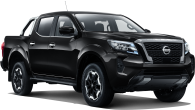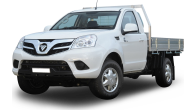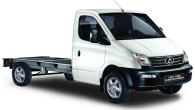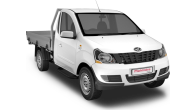Clear evidence of the fierce competition in Australia’s booming 4x4 ute segment is that a well-built vehicle with the all-around competence of Mazda’s BT-50 attracts less than 6.0 per cent of total sales. It’s also currently outsold by its Ford Ranger birth-twin by more than four to one.
While the Mazda’s (ahem) ‘bold’ styling does not seem as confronting as it did when launched back in 2011, the current BT-50 has never enjoyed anywhere near the sales volume of Ford’s 2017 4x4 market leader; a situation not helped by the Ranger’s significant PXII mid-life cosmetic and engineering update which far exceeded Mazda’s comparatively token effort.
As a result, the BT-50 is now starting to show its age, but with attractive pricing and effortless load-lugging ability Mazda’s big bruiser still offers a lot of ute for the money.
Mazda BT-50 2018: Gt (4X4)
| Engine Type | Diesel Turbo 5, 3.2L |
|---|---|
| Fuel Type | Diesel |
| Fuel Efficiency | 8.9L/100km (combined) |
| Seating | 5 |
| Price From | $28,160 - $33,880 |
| Safety Rating |
|
Does it represent good value for the price? What features does it come with?
We went straight to the top with the 4x4 dual cab GT, which is available with a six-speed manual ($52,490), or six-speed auto like our test vehicle ($54,090). Given the GT is the highest model grade available in the BT-50 range, its pricing looks good against rival premium 4x4 dual cab offerings like the more lavishly equipped Toyota Hilux SR5+ auto ($58,440) and Ford Ranger Wildtrak auto ($60,090).
The GT specification includes black leather-trim for the seats, steering wheel and gearshift handle, eight-way power adjustable driver’s seat, dual-zone air conditioning, multiple connectivity multimedia system with 8.0-inch colour touchscreen and digital (DAB) radio, 17-inch alloys with 265/65 R17 tyres and a full-size steel spare, rain-sensing wipers, chrome rear bumper, polished tubular side-steps, privacy glass and more. However, we reckon at least a tow bar and tonneau cover should be standard at this premium model grade.
.jpg)
Our test vehicle was also fitted with some Mazda genuine accessories including a black steel bull bar ($2538.63), driving lights ($825.93), wired 3.5 tonne tow-bar ($1017.67), dual battery kit ($1296.79), soft tonneau ($748.54) and embossed load floor mat ($426.84). They all look great and work well, but combined would add almost $6900 to the vehicle’s purchase price, pushing it above Ford's Wildtrak.
Is there anything interesting about its design?
The Ranger and BT-50 were jointly designed and developed, sharing chassis, body hard-points and mechanicals. However, it was Mazda’s bold decision to make the BT-50’s styling distinctly different from the Ranger – and to look more like a car - that has polarised opinion ever since.
.jpg)
Looks aside, it’s still an excellent vehicle for a variety of work and play roles, particularly if they require carrying or towing big loads. The rugged steel ladder-frame chassis, expansive 3220mm wheelbase, sure-footed 1560mm track width and heavy duty leaf-spring rear axle make a rock-solid platform for these tasks, combined with responsive rack-and-pinion steering, strong front disc/rear drum braking and a suite of dynamic safety features.
Cabin comfort is best for driver and front passenger. Rear seating is non-adjustable, more upright and less comfortable, particularly if there are three adults and you’re sitting in the slightly-raised centre position with your head much closer to the roof lining, shoulders rubbing either side, knees pushed together to fit between the front seats and feet spread either side of the transmission tunnel. Like most dual cabs, it’s realistically a four-seater for any trip longer than the local shops.
.jpg)
Off road credentials are still amongst the best for this segment though, with up to 237mm of ground clearance, a 28.2 degree approach angle, 26.4 degrees departure angle, 25.0 degree ramp break-over angle and enviable 800mm wading depth.
.jpg)
What are the key stats for the engine and transmission?
One of the BT-50’s enduring strong points is the Euro 5-compliant 3.2-litre in-line five-cylinder turbo-diesel shared with the Ranger. With its intercooled, 20-valve, DOHC design and drive-by-wire (Wi-Fi) throttle control, this loping, low-stressed unit churns out 147kW at 3000rpm and 470Nm of torque between 1750-2500rpm, which makes light work of city/suburban commutes during the week and lugging your caravan, boat or horse-float on weekends.
.jpg)
The six-speed ‘intelligent’ automatic transmission is also a proven performer, with 'Active Adaptive Shift' (AAS) that optimises the selection of its six ratios to suit different driving styles. There’s also a sport mode for sharper acceleration and the option of sequential manual shifting, which is great when hauling heavy in hilly country or you need to quickly select a lower gear to exploit its excellent engine braking on steep descents.
The dual-range, part-time, 4x4 transmission with 2.718:1 low range reduction and super low 42.3:1 crawler gear is controlled by a dial on the console, with the ability to select hi-range 4x4 on the move most handy on slippery gravel or icy roads. A console button electronically locks the rear differential for the really tough stuff.
How much fuel does it consume?
Mazda’s official combined cycle figure is 10.0L/100km and the dashboard display was close to that figure, never budging from 10.4 for the duration of our test. However, the numbers we calculated from two tank top-ups, based on trip meter and fuel bowser readings, resulted in figures of 12.7 (worst) and 11.8 (best). Based on our best number, you could expect a driving range of around 680km from its 80-litre tank.
How practical is the space inside?
The BT-50 GT shares the same 3200kg GVM rating as the Ranger, so with a 2118kg kerb weight it’s rated to carry a big 1082kg payload, giving it genuine ‘one tonner’ status that not all 4x4 dual cab utes can claim.
Like the Ranger it’s also rated to tow up to 3500kg of braked trailer. That benchmark figure looks great in ads and sales brochures, but the sobering fact is (and this also applies to the Ranger) that you would have to reduce the payload by a whopping 700kg to avoid exceeding the 6000kg GCM (or how much you can legally carry and tow at the same time). And that would leave only 382kg of payload capacity.
.jpg)
Our best advice is to base your peak towing figure on the BT-50’s 3200kg GVM, to give you back that massive 700kg of lost payload capacity. In other words, if you deduct the 3200kg GVM from the 6000kg GCM, it can legally tow up to 2800kg. And that’s a far more realistic and practical figure in the ‘real world’ of towing.
The cargo box floor is 1549mm long and 1560mm wide with 1139mm between the wheel arches and plenty of well-placed anchorage points. You won’t squeeze a standard Aussie 1160mm-square pallet in there, but it will carry some mountain bikes and motor bikes diagonally with the tailgate closed. The steel box housing the second battery, positioned in the left rear corner, reduces the load floor space.
.jpg)
Cabin storage options include pockets and bottle holders in the base of each door, plus a small driver’s side pull-out compartment on the lower dash, small cubby inset in the centre dash-pad, single glovebox and overhead sunglass storage. The centre console adds a front cubby, two central cup holders and a rear storage box with padded lid that doubles as an armrest.
The rear bench seat’s centre fold-down armrest has two more cup holders and there’s a stretchy map pocket on the rear of the front passenger seat (why not on the driver’s seat, too?) The bench seat base also swings up through 90 degrees to reveal two handy hidden storage compartments beneath it, with a strap and hook to hold the seat base in a vertical position when accessing them.
.jpg)
What's it like to drive?
Overall the BT-50 feels like the Ranger did before its mid-life upgrade. The inherent sure-footed handling, ride quality and braking is still there, along with the low-stressed throb of the five-cylinder turbo-diesel and its efficient six-speed auto.
The most noticeable difference is the steering. When Ford went its own way with a new electrically power-assisted system in the PXII, Mazda stuck with the original hydraulic set-up and a steering weight that remains more linear and firmer in feel regardless of road speed. As a result, the BT-50 feels a bit more truck-like to drive, which is most noticeable in city and suburban driving when parking is a regular requirement.
At highway speeds (100km/h) the cabin environment is quiet and civilised, with the big 3.2 litre engine ticking over at only 1750rpm which is at the base of its peak torque curve. At 110km/h the revs only increase to 2000rpm, with torque to burn if you’ve got a big payload or trailer or both.
To test its one tonne-plus payload rating we inflated the tyres to their recommended pressures (38psi front/44psi rear) and loaded 770kg on board, which with a full tank of diesel, a driver and the combined weight of genuine accessories equalled a payload of more than 1000kg.
And it’s under these loads that the BT-50 really shines, with the rear leaf spring packs compressing just under 50mm (with heaps of bump-stop clearance) and the nose rising 20mm with no noticeable decline in steering or front brake response. At highway speeds the ride quality becomes smoother, with the heavily-loaded suspension soaking up the bumps with ease, tracking straight and maintaining its reassuring composure on potholed bitumen and gravel back roads.
The BT-50 also easily cleared our 13 per cent gradient 2.0km set climb at 60km/h, self-shifting back to fourth and settling at 2250rpm all the way to the top with a light throttle. On the way down, with second gear manually selected to test engine braking, it peaked at 3950rpm on over-run (4900rpm redline) and confidently restrained its one-tonne payload without once having to touch the brake pedal. That’s really good engine braking, as most utes we’ve tested can’t do this. Most impressive.
Our only major criticism is the digital (DAB) radio. Sound quality when you have a good signal is excellent, but the audio continually drops out with silence sometimes lasting for minutes at a time. And beyond metro areas, there's literally more silence than sound. It doesn’t work in tunnels either and the control screen interface is not user-friendly or intuitive, even for tech-savvy teenagers.
Warranty & Safety Rating
What safety equipment is fitted? What safety rating?
The BT-50 scores a five star ANCAP rating with front/side airbags for driver and front passenger plus side curtain airbags front and rear. The rear seat has two child restraint anchor points but no ISOFIX.
The dynamic stability control (DSC) menu includes crucial load-carrying features like trailer sway control (a must), load adaptive control, electronic brake-force distribution, emergency brake assist, hill descent control and hill launch assist. There’s also a reversing camera but no AEB, which is now overdue, not only in BT-50, but across the entire ute segment.
What does it cost to own? What warranty is offered?
Mazda offers a two year/100,000km warranty for the BT-50. If 100,000km is not reached within two years, warranty cover automatically extends to three years or 100,000km whichever comes first. Roadside Assistance is available at extra cost.
Scheduled servicing is due every 10,000km with alternating capped prices of $401 and $541 for each service up to 50,000km.
Verdict
Proof of the benchmark excellence of the BT-50’s original engineering package when launched in 2011 is that it can still hold its own seven years later, in a 4x4 dual cab ute segment which has never been more competitive.
It looks and feels a bit outdated compared to the PXII Ranger, the warranty could do with a refresh and the GT could do with more standard equipment, to reflect its premium model status and potentially attract more buyers. Even so, it’s still a very capable all-rounder and amongst the best in class for heavy load-hauling. And we’re sure your local Mazda dealer will be super keen to do a deal.
Pricing Guides







.jpg)
.jpg)

















.jpg)



